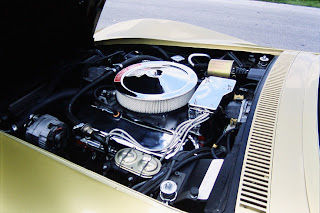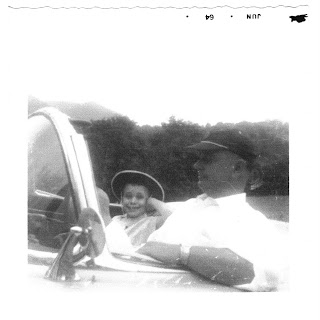The Numbers Matter
Text and Photography by David W. Temple
There is a disclaimer that frequently appears in most literature related to stocks and bonds as well as associated funds which says that “Past performance is no guarantee of future performance.” That disclaimer could have appeared in Corvette sales literature in the early days of the sports car. In this case, the poor performance in terms of sales should have guaranteed the termination of the model. The fiberglass Vette was not much in terms of sportiness – not with a somewhat modified “Stovebolt Six” under the hood and other shortcomings. Chevrolet limited production to just 300 units for 1953, but had expected to boost production to about 1,000 per month for ’54. Actual production amounted to only 3,640 with some of those left unsold when the 1955 model year arrived. With results like that what could possibly guarantee the model would even exist for 1956? An engineer named Zora Arkus-Duntov is what guaranteed future existence as well as future performance.
Duntov joined GM just in time. He knew what had to be done to save the Vette which was to make it the car that enthusiasts expected it to be. At first, even the new V8 for ’55, was not enough (only 700 Vettes built that year), but with constant upgrades and racing successes along the way, production surpassed the 10,000 mark for 1960. With the all-new Sting Ray for ’63, output would be more than double that figure.
The Corvette was really different for 1963. This marked the first time a closed version had been offered which was officially dubbed the Sting Ray Sport Coupe. The fastback roofline and sloping front end with hidden headlights (a first on the Corvette) provided a sleek profile. The body design which was based on the 1959 XP-720 concept car had been tested and refined via Cal Tech’s wind tunnel. The aerodynamic fastback body had one controversial feature – the divided backlight. This had been the idea of styling chief, Bill Mitchell, who believed it was an important part of the car’s appearance. Others disagreed, but the feature was left in place for the ’63 model year. (Some owners did not care what Bill Mitchell thought; they preferred not having a blind spot and when the ‘64s arrived with a one piece backlight, many who disliked the feature had the offending divider removed from their ’63, and had the new arrangement installed. Today, collectors pay a premium for the one year only “split window coupe.”) The convertible body style remained and as had been the practice since 1956, both a bolt-on hardtop and a soft top could be had. Production was nearly evenly divided between the two body styles with the convertible edging out its companion fastback by 325 units; a total of 21,513 Corvettes were assembled for ’63.
Besides having a one-piece backlight for the coupe, the ‘64s offered other refinements. These included variable rate springs for a softer ride and a horsepower boost for the top two engine options. More rubber insulators were used to further minimize road noise. Less noticeable were altered rocker moldings with fewer and wider stripes and steel headlight housings instead of the fiberglass examples of ’63. More obvious was the lack of the pair of chrome-plated, simulated grilles on the hood, though the recesses were retained. Wheel covers were updated as well. Exterior paint color choices remained almost unchanged with the exception of a new shade of silver as a regular option. Silver was an extra-cost color in ’63. The extra-cost paint option was changed to either a non-standard color or for delivery in primer; only 24 customers opted for special paint. Subtle changes marked the ’64 interior, too; among other things, the seat bolsters were widened slightly, the instrument faces received a revised finish, and a simulated-walnut steering wheel was installed.
Production of the 1964 models increased to 22,229 copies, however, preference for the convertible shifted greatly. Nearly 63 percent of the total production was accounted for with the drop-top body style. The Daytona Blue 1964 Sting Ray convertible shown here obviously represents the majority choice of body style, but this particular car was very rare when new and is much more so today. What the reader sees here is just 1 of 138 convertibles ordered with the 365hp engine (option code L76) and air conditioning. Other interesting total production numbers include 7,171 with the L76 engine; M20 close-ration four-speed production of 8,496; just 919 ordered with air conditioning; 486 with the 3.55:1 posi-traction rear end; 3,454 painted Daytona Blue, and 4,843 with the optional white (convertible) top (with black being the standard color). Interestingly, nearly 86 percent of the total 1964 Vette output were equipped with the four-speed transmission and less than 15 percent were powered with the base 250hp 327. Clearly, most buyers of the Corvette Sting Ray desired performance from their car and just as clear is that the Vette had matured into a true sports car.
Feature car owner, Danny Reed of Austin, Texas, is a Corvette enthusiast to say the least. He has owned a ’63 “Split Window” coupe and also a ’65 coupe in the past. Danny currently owns another Corvette – a 1969 model formerly driven by Apollo 12 moonwalker Alan Bean – which is featured elsewhere in this blog and was the cover car for the August 2001 issue of Car Collector. Both cars have garnered prestigious awards thanks to the efforts of Danny and his choice of Corvette restoration specialist, Ray Repczynski.
While the refurbishment of the ’69 was ongoing at Ray’s shop near Houston, Danny discovered the ’64 which was also at the shop. The restoration of the ’64 had already been underway by that time and was partially completed. However, the owner of the car had lost interest in the project and was ready to sell. Many potentially interested collectors passed on the project. Danny carefully evaluated the dismantled Vette and saw the value of the car. He said the car “looked like a basket case”, but noted the frame had been dipped and repainted, the body was stripped, the driveline was numbers matching and bolted in place, the interior was ready to install, the gauges had been rebuilt, and most of the parts appeared to be present. Missing parts included window glass, relays, wiring, rubber seals, seat belts, and various nuts and bolts. The air conditioning, brakes, water pump, and radio needed rebuilding. “Since I don’t like surprises, we rebuilt the engine, carburetor, transmission, rear end, drive shafts, and suspension.” said Danny. He also noted that, “Ray did an outstanding job preparing the fiberglass body. He primed and painted the body in lacquer to the original specs and color.” In this case “original” really means original – not base coat/clear coat with a shine so deep it appears one could walk into the reflected scene. This car has been awarded “Top Flight” status from the National Corvette Restorers Society (NCRS); original to that group means factory specifications in all areas. To get the “Top Flight” award, the car must be judged with a minimum net score of 94 points. This car received 99.6 points at the NCRS Flight Judging in Dallas in May of 2003. Since then, the car received another “Top Flight” award at the NCRS Regionals in Waco, Texas. Furthermore, first place and “Most Outstanding Restored Antique” awards were added to the trophy case at the 30th Annual Custom Car and Hot Rod Show in Austin.
Those achievements were the result of a meticulous, thoughtful restoration. Danny had a plan he followed regarding the restoration of his Corvette. He explained, “First we compiled a list of what we had, what needed to be repaired, and what we needed to order or find. This takes days and the experience of a master – in this case, Ray.” He advised anyone who is considering the restoration of a Corvette “to go to a professional in the business of restoration – someone that knows what to look for and where to look for it. Pay whatever it cost to get a professional to thoroughly check your potential project – put it on a lift, check the frame and suspension, look for hidden damage. Decide what you want to have before you start – a totally restored car or a nice driver. Get a specifications guide and check and recheck the numbers.” Building a numbers matching car will be more expensive if certain components are missing. Certain options add significantly to the value of the car. One must understand the data plate and the casting numbers. As Danny said, “The numbers matter.”
Specifications
Base price: $4,037
Engine: 327cid V8 (L76)
Horsepower: 365@6,200rpm
Torque: 350@4,000rpm
Cam: High-lift with solid lifters
Bore and Stroke: 4.00 x 3.25 inches
Carburetion: Holley 4150C aluminum four barrel
Exhaust: dual
Transmission: four-speed manual
Rear End: 3.55:1 posi-traction
Production: 138*
Wheelbase: 98 inches
Performance
0-100mph: 14.7 seconds (375hp engine)
* Total convertible production was 13,925.








































